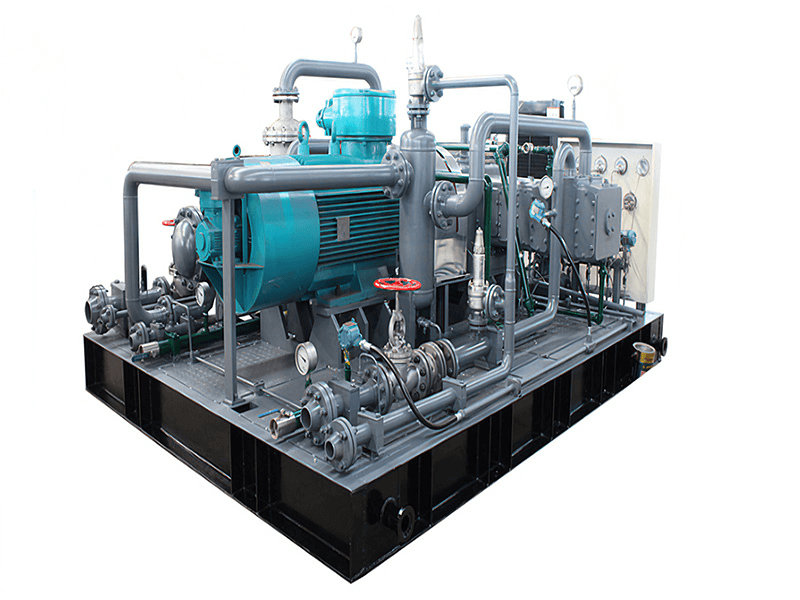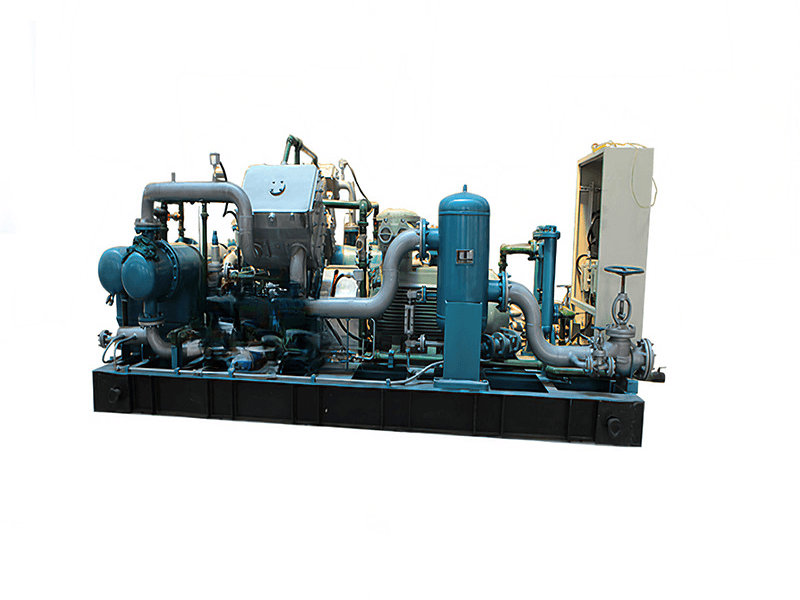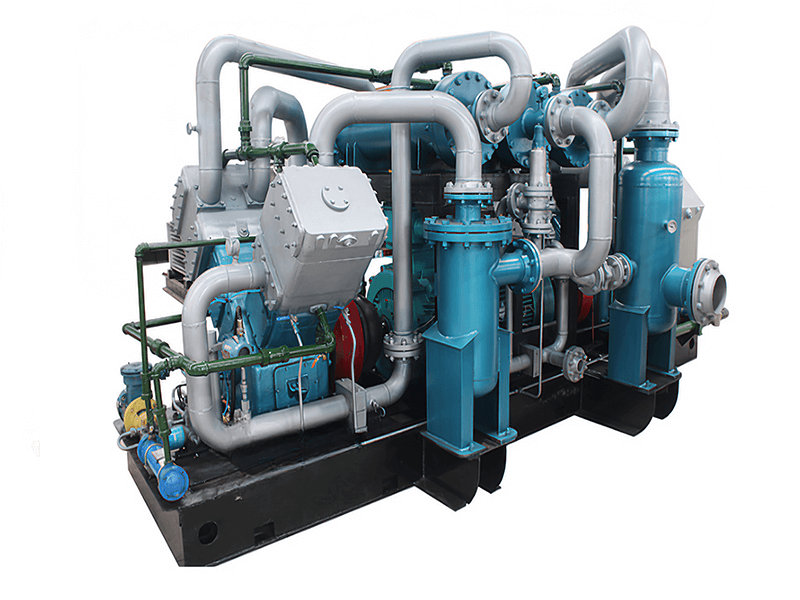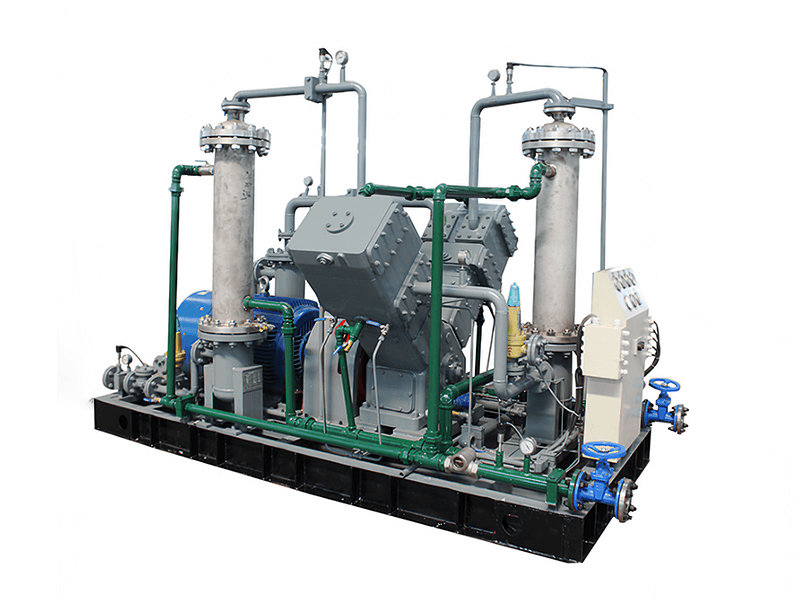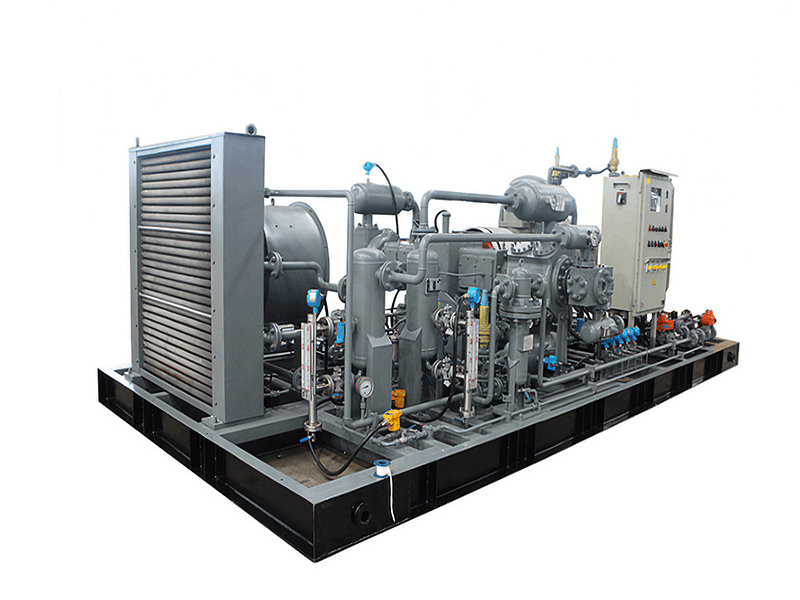Helium, as a scarce strategic resource, is irreplaceable in low-temperature superconductivity, semiconductor manufacturing, aerospace propulsion and other fields due to its extremely low boiling point (-268.9℃), chemical inertness and high thermal conductivity. Global helium resources are highly concentrated, and purification and liquefaction processes are the core links of the helium industry chain. Piston compressors occupy a key position in the helium compression, purification and liquefaction process with their high pressure ratio, low flow adaptability and reliability. However, the characteristics of helium such as small molecular weight (4g/mol), strong permeability and liquefaction temperature close to absolute zero pose severe challenges to compressor design. This paper systematically analyzes the key technological breakthroughs of piston compressors in helium purification and liquefaction, and combines typical engineering cases to explore its engineering practice and future development direction.
Ⅰ. Technical challenges of helium purification and liquefaction process
1. Core difficulties brought by the physical and chemical characteristics of helium
Ultra-low boiling point: liquefaction needs to reach -268.9℃, and multi-stage compression and deep refrigeration are required. Energy loss accounts for more than 60% of the total energy consumption of the process.
High permeability: The diameter of helium molecules is only 0.26nm, which is easy to leak through micron-level gaps, and the sealing system design is difficult.
Impurity sensitivity: Light impurities such as neon and hydrogen will significantly increase the liquefaction temperature, and the front-end purification is required to be above 99.999% (5N level).
2. Requirements for key links in the process chain
Crude helium purification: compress helium-containing natural gas (helium concentration 0.1%~7%) to 2~5MPa, and remove impurities through membrane separation or low-temperature adsorption.
High-pressure liquefaction: compress high-purity helium to 15~25MPa, and cool it to liquid state step by step through expanders and heat exchangers.
Storage and transportation safety: Liquid helium needs to maintain ultra-low temperature below 1.2K, and the compression process needs to avoid gasification losses caused by temperature rise.
Ⅱ. Key technologies of piston compressors in helium process
1. Low temperature resistant materials and sealing technology
Material selection: Cylinders and valves are made of austenitic stainless steel (316LN) or nickel-based alloy (Inconel 625) to avoid low temperature embrittlement (impact toughness > 100J at -269℃).
Sealing system innovation:
Main seal: metal bellows + flexible graphite ring combination, resistant to -200℃ low temperature and 20MPa high.
Auxiliary seal: helium mass spectrometer leak detector online monitoring, leakage rate ≤1×10⁻⁹ Pa·m³/s.
2. Multi-stage compression and thermodynamic optimization
Stage configuration: Design 4~6-stage compression, single-stage compression ratio ≤2.5, total outlet pressure can reach 25MPa.
Interstage cooling scheme:
Precooling stage: The first two stages are cooled by liquid nitrogen (-196℃) to reduce compression power consumption.
Deep cooling stage: The last two stages are combined with helium expanders, and the temperature gradient control accuracy is ±0.5K.
3. Impurity control and purification integration
Pre-purification module: The molecular sieve adsorption tower and palladium membrane are integrated at the compressor inlet, and the removal rate of neon and hydrogen impurities is >99.9%.
Online purity monitoring: A quadrupole mass spectrometer (QMS) is used to provide real-time feedback on helium purity (≥99.999%).
4. Energy efficiency improvement technology
Waste heat recovery: The compression heat is used to regenerate the molecular sieve or preheat the intake air, and the system energy efficiency is improved by 12%~18%.

III. Typical engineering case analysis
Case 1: Purification upgrade project of the US Federal Helium Reserve
Background: The world's largest helium reserve, annually processing 500 million cubic meters of helium-containing natural gas, with a helium concentration of 2.5%.
Technical solution:
Four-stage piston compressors in series, single-stage pressure ratio 2.2, outlet pressure 4.5MPa.
TiN coating sprayed on the inner wall of the cylinder reduces the friction coefficient by 40%.
Integrated membrane separation + low-temperature adsorption two-stage purification, helium purity reaches 99.9993%.
Results: Helium recovery rate increased from 85% to 92%, and annual production of liquid helium increased by 120 tons
Case 2: Helium cryogenic system of European Organization for Nuclear Research (CERN)
Challenge: To supply superfluid helium (1.9K) to the Large Hadron Collider (LHC), helium needs to be continuously compressed to 18MPa.
Innovative design:
Six-stage oil-free piston compressor, outlet pressure 18MPa, equipped with liquid helium pre-cooling (4.5K).
The piston rod is made of carbon fiber composite material, which reduces the mass by 30% and the vibration amplitude by 50%.
The digital twin system optimizes the compression-expansion cycle in real time, reducing energy consumption by 22%.
Benefits: The system has been running continuously for 10 years, and the stability of liquid helium supply has reached 99.98%.
Case 3: Helium Liquefaction Plant in Northeast Sichuan, China
Demand: Processing helium-containing natural gas (helium concentration 0.8%), annual production of 50 tons of liquid helium.
Solution:
Three-stage piston compressor + Brayton refrigerator combined process, liquefaction rate increased to 85%
The sealing system adopts "metal honeycomb + nanographite" structure, and the leakage rate is <5×10⁻⁸ Pa·m³/s.
The AI algorithm dynamically adjusts the compression stage to adapt to the fluctuation of gas source concentration (0.5%~1.2%)
Achievements: Unit liquid helium energy consumption is reduced to 18kWh/m³, reaching the international advanced level.
IV. Technical Challenges and Countermeasures
1. Insufficient long-term effectiveness of ultra-low temperature sealing
Countermeasures: Develop metal organic framework (MOF) coating sealing materials, and reduce low-temperature permeability by 90%
2. Low economic efficiency of helium recovery
Countermeasures: Promote helium closed cycle process, and increase the recovery rate to more than 95%
3. High initial investment in equipment
1. Insufficient long-term ultra-low temperature sealing
Countermeasures: Develop metal organic framework (MOF) coating sealing materials to reduce low-temperature permeability by 90%
4. Low economic efficiency of helium recovery
Countermeasures: Promote helium closed cycle process and increase recovery rate to more than 95%.
5. High initial investment in equipment
Countermeasures: Modular design of compression-liquefaction unit to reduce construction cost by 30%.
V. Future development trends
Ultra-high pressure liquefaction technology: Develop 30MPa compressor to support the demand for liquid helium in deep space exploration.
Zero leakage sealing system: Based on quantum sensing technology, the leakage rate is ≤1×10⁻¹² Pa·m³/s.
Green power drive integration: Couple photovoltaic/wind power to build a zero-carbon helium liquefaction plant.
Intelligent process chain: Apply machine learning to optimize the parameters of the entire process of purification-compression-liquefaction.
Conclusion
Piston compressors play a core role in boosting and thermal cycle drive in helium purification and liquefaction processes. Through the innovation of cryogenic materials, multi-stage compression optimization and breakthroughs in intelligent control technology, its application in crude helium purification, high-pressure liquefaction and other links has achieved remarkable results. Cases such as the US Federal Helium Bank and CERN have shown that high-reliability design and system integration can greatly improve helium recovery rate and energy efficiency. In the future, with the deep integration of ultra-high pressure technology and green energy, piston compressors will help break through the bottleneck of helium resources and support the development of cutting-edge technology and high-end manufacturing.














